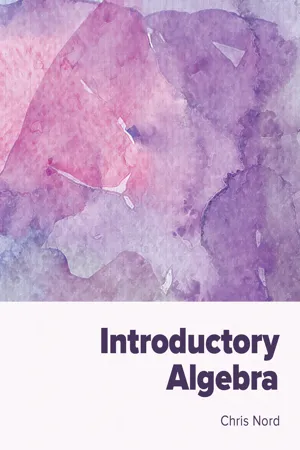eBook - ePub
Introductory Algebra
About this book
Introductory Algebra provides precollege algebra students with the essentials for understanding what algebra is, how it works, and why it useful. It is written in plain language and includes annotated examples and practice exercises so that even students with an aversion to math will understand these ideas and learn how to apply them. This precollege algebra textbook introduces students to the building blocks of algebra that they need to progress with mathematics at the college level, including concepts such as whole numbers, integers, rational numbers, expressions, graphs and tables, and proportional reasoning. Written by faculty at Chemeketa Community College for the students in the classroom, Introductory Algebra is a classroom-tested textbook that sets students up for success.
Frequently asked questions
Yes, you can cancel anytime from the Subscription tab in your account settings on the Perlego website. Your subscription will stay active until the end of your current billing period. Learn how to cancel your subscription.
At the moment all of our mobile-responsive ePub books are available to download via the app. Most of our PDFs are also available to download and we're working on making the final remaining ones downloadable now. Learn more here.
Perlego offers two plans: Essential and Complete
- Essential is ideal for learners and professionals who enjoy exploring a wide range of subjects. Access the Essential Library with 800,000+ trusted titles and best-sellers across business, personal growth, and the humanities. Includes unlimited reading time and Standard Read Aloud voice.
- Complete: Perfect for advanced learners and researchers needing full, unrestricted access. Unlock 1.4M+ books across hundreds of subjects, including academic and specialized titles. The Complete Plan also includes advanced features like Premium Read Aloud and Research Assistant.
We are an online textbook subscription service, where you can get access to an entire online library for less than the price of a single book per month. With over 1 million books across 1000+ topics, we’ve got you covered! Learn more here.
Look out for the read-aloud symbol on your next book to see if you can listen to it. The read-aloud tool reads text aloud for you, highlighting the text as it is being read. You can pause it, speed it up and slow it down. Learn more here.
Yes! You can use the Perlego app on both iOS or Android devices to read anytime, anywhere — even offline. Perfect for commutes or when you’re on the go.
Please note we cannot support devices running on iOS 13 and Android 7 or earlier. Learn more about using the app.
Please note we cannot support devices running on iOS 13 and Android 7 or earlier. Learn more about using the app.
Yes, you can access Introductory Algebra by Chris Nord in PDF and/or ePUB format, as well as other popular books in Mathematics & Algebra. We have over one million books available in our catalogue for you to explore.
Information
CHAPTER 1
Whole Numbers
What Are Numbers?
You know the answer to this question, of course, because you’ve been using numbers for most of your life. You use them every day. However, as you will see in the chapters to come, numbers can be a little more complicated than those things you use to count the money in your wallet or the people in front of you in the express lane at the grocery store. We will return to this question about what numbers are at the beginning of each chapter, and with each return, we’ll add a new layer of sophistication to the answer.
To start, we’ll just say that numbers are symbols that we use to count objects in a collection. This set of numbers is called the whole numbers. The whole numbers are {0, 1, 2, 3, 4, …}. With the exception of zero, which has only been considered a number for about 1400 years, the set of whole numbers is as old as human civilization. In fact, there is some evidence of a surprisingly sophisticated innate understanding of numbers among several non-human species in the animal kingdom, too, so it may be that some version of the set of whole numbers predates humanity.
While there is a smallest whole number, zero, there is no greatest whole number. With any given whole number, there is always a next whole number that is greater than the given number.
In this chapter, we will explore the arithmetic of whole numbers and introduce the concept of an equation in the context of whole numbers. This chapter lays the foundation for the rest of the book, but it’s important to remember that this chapter also rests on its own foundation — the ancient and basic concept of counting.
1.1 Addition and Subtraction
When we’re presented with two collections of objects, we can count them separately, or we can combine them into a single collection and count them together. In this section, we will introduce the mathematical operation called addition, which encodes the relationship between these two ways of counting, and explore its properties.
If we wish to remove any objects from a collection of objects, we can either count the number of objects before any are removed and then count the number of objects that are removed, or we can count the number of objects that remain after we are finished removing objects. In this section, we will also introduce the mathematical operation called subtractio...
Table of contents
- Cover
- Title Page
- Copyright
- Contents
- Chapter 1: Whole Numbers
- Chapter 2: Integers
- Chapter 3: Rational Numbers
- Chapter 4: Expressions
- Chapter 5: Graphs and Tables
- Chapter 6: Proportional Reasoning
- Solutions to Odd-Numbered Exercises
- Glossary/Index
